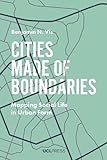Cities made of boundaries : [electronic resource] mapping social life in urban form / Benjamin N. Vis.
Material type: TextPublication details: London : UCL Press, 2018.Description: 1 online resourceISBN:
TextPublication details: London : UCL Press, 2018.Description: 1 online resourceISBN: - 9781787351059
| Item type | Current library | Call number | Status | Date due | Barcode | |
|---|---|---|---|---|---|---|
| E-Resources | Main Library E-Resources | 307.76 V822 (Browse shelf(Opens below)) | Available | E004408 |
Intro; Half Title; Title Page; Copyright Page; Dedication; Acknowledgements; Contents; List of Figures; List of Tables; List of Abbreviations; Introduction to Cities Made of Boundaries; The rationale; The questions; The content; The book; Chapter 1 Towards Radical Comparative Urban Studies; Introduction; Urban studies; Urban origins; Categorical cities; Comparative urbanism; Social practice based definition of cities; What to study comparatively; Representation and meaning; Environmental determinism; Low-level meaning (avoiding conflation); Research practice Chapter 2 Adapting a Critical Realist Research ProcessIntroduction; Philosophical position; Geography and archaeology; Materiality; The material; The material inhabited built environment; Embedding the research process; Spatial (in)dependence; The social; Iterative abstraction; Chapter 3 Constituting Built Environments, Establishing Boundaries; Introduction; Reasoning towards a theoretical framework; The condition of being human; Human being in the spatial world; Empty space; Primordial space; Equalitarian space; Marked space; Filled space; Human being in the social world Individual human beingEncounter; Projects and institutions; Autopoietic socio-spatial systems; Inhabited built environment; Boundaries; Chapter 4 Theorising Material Boundaries, Understanding Spatial Data; Introduction; Theorising boundaries; Thinking beyond categories; Consolidation and classification; Studying boundaries; Boundaries in the inhabited built environment; Boundary compositions in built environment configurations; Fiat and bona fide boundaries; Conceptual series towards spatial data; Ideational and empirical boundaries; Built boundaries; Boundary lines Visualised or presented dataTowards an ontology of analytical units; Chapter 5 An Ontology of Boundary Line Types; Introduction; Requirements for the ontology; Formulating a BLT ontology; BLT definitions; Closing boundaries (1); Facing boundaries (2); Associative boundaries (3); Extended facing boundaries (4); Directing boundaries (5); Virtual boundaries (V); Disclosing boundaries (6); Enclosing boundaries (7); Mutual boundaries (8); Opening boundaries (9); Neutral boundaries (10); Negative definitions; Man-made boundaries of unoccupiability (11) Not man-made boundaries of unoccupiability (12)Not man-made negative boundaries (13); Levels of socio-spatial significance of BLTs; Towards practice; Chapter 6 A Constructive Evaluation of Methods on Urban Form; Introduction; Considering methods for studying urban built form; Urban historical GIS; Historical GIS (HGIS) for cities; GIS-aided historically reconstructed city plans; GIS-based approach to studying urban built form; Urban morphology; Background to the method; The practice of town plan analysis; Emerging terms and processes; Space syntax; Background to the method
Cities Made of Boundaries presents the theoretical foundation and concepts for a new social scientific urban morphological mapping method, Boundary Line Type (BLT) Mapping. Its vantage is a plea to establish a frame of reference for radically comparative urban studies positioned between geography and archaeology. Based in multidisciplinary social and spatial theory, a critical realist understanding of the boundaries that compose built space is operationalised by a mapping practice utilising Geographical Information Systems (GIS). Benjamin N. Vis gives a precise account of how BLT Mapping can be applied to detailed historical, reconstructed, contemporary, and archaeological urban plans, exemplified by sixteenth- to twenty-first century Winchester (UK) and Classic Maya Chunchucmil (Mexico). This account demonstrates how the functional and experiential difference between compact western and tropical dispersed cities can be explored. The methodological development of Cities Made of Boundaries will appeal to readers interested in the comparative social analysis of built environments, and those seeking to expand the evidence-base of design options to structure urban life and development.
There are no comments on this title.

